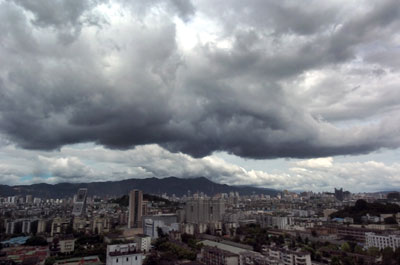At least 466,000 people, including 266,000 in Fujian and 200,000 in Zhejiang
have been evacuated as Saomai, which has grown to a powerful typhoon, is
approaching the coastal areas of the two provinces in east
China.
Meteorologists said Saomai, the eighth storm to hit China this
year, would probably land between Lianjiang of Fujian and Yuhuan of Zhejiang on
Thursday noon or evening.

Clouds gather over
Fuzhou, east China's Fujian province August 10, 2006 as Saomai, the
strongest typhoon in 40 years, is to land later in the day.
[Xinhua] |
At around 11:00 p.m. on Wednesday, local
observatory said, Saomai, which is the Vietnamese name for the planet Venus, was
located at latitude 25.7 north and longitude 124.4 east, approximately 480 km
southeast of Zhejiang's Wenzhou.
With winds recorded at 216 km per hour
at its eye, the typhoon was moving northwest at a speed of 30 km per hour at
midnight Wednesday. Forecasters from Zhejiang said Wenzhou would be under a
head-on attack by the powerful storm.
The Central Meteorological
Observatory (CMO) yesterday predicted Typhoon Saomai will make landfall in
Fujian and Zhejiang provinces.
Saomai comes hot on the heels of Typhoon Prapiroon, which killed around 80
people in South China last week.
And as the typhoon nears, a weaker storm, Bopha, is closing in on the
Guangdong coast.
"Saomai will affect regions south of the Yangtze River and coastal areas in
Fujian Province," said CMO meteorologist Xu Yinglong.
The typhoon is expected to wreak further havoc as it moves northwest after
landing, but Xu said the damage will not be as severe as the destruction wreaked
by Typhoon Bilis, which caused hundreds of deaths in southern China last month.
Considering the distance between Saomai and Bopha, interaction between the
two storms will not be as "mighty," meteorologists said.
Saomai, the eighth tropical storm to close in on China this year, was about
840 kilometres southeast of Wenzhou in East China's Zhejiang Province yesterday.
Local authorities in Zhejiang began evacuating residents as a combination of
heavy rain, gusty winds and a high tide, all caused by Saomai, began assaulting
the area.
Residents in mountainous areas around Wenzhou, Taizhou, Ningbo and Lishui
were advised to beware of possible landslides, mud-rock flows, floods and other
disasters, while schools were ordered to prepare for the storm.
Vice-Premier Hui Liangyu has urged meteorological observatories to keep a
keen eye on the typhoon.
Gathering strength, Saomai was moving in a northwest-west direction between
25 and 30 kph, and expected to enter the East China Sea either last night or
this morning.
It is expected to come ashore between noon and early this evening at the
coastal areas between Wenling in Zhejiang and Changle in Fujian.
Due to the typhoon's influence, Zhejiang is likely to experience a
combination of heavy rain, strong winds and high tides.
The Office of Flood and Drought Relief in Zhejiang has ordered all ships to
return to harbour and warned sea-based businesses to prepare for potential
losses.
In Taizhou, more than 7,000 fishing boats have sought shelter, an official
with the city's anti-flood department said yesterday. In Ningbo, the number
stood at more than 10,000.
"We have issued documents ordering all of those dwelling behind unsecured
seawalls to be evacuated," said an official, surnamed Xu, from Ningbo's
anti-flood department.